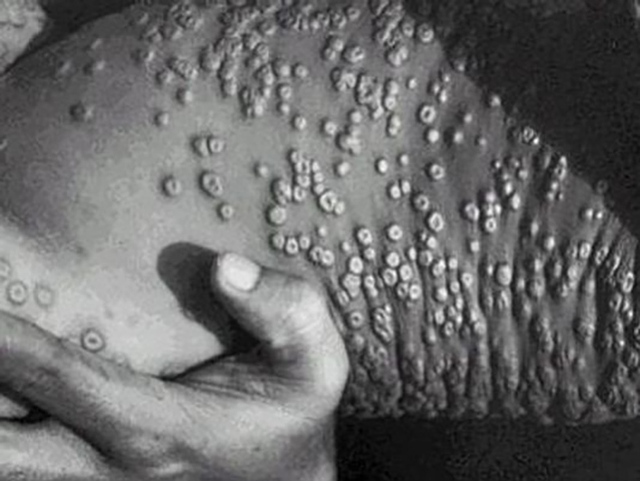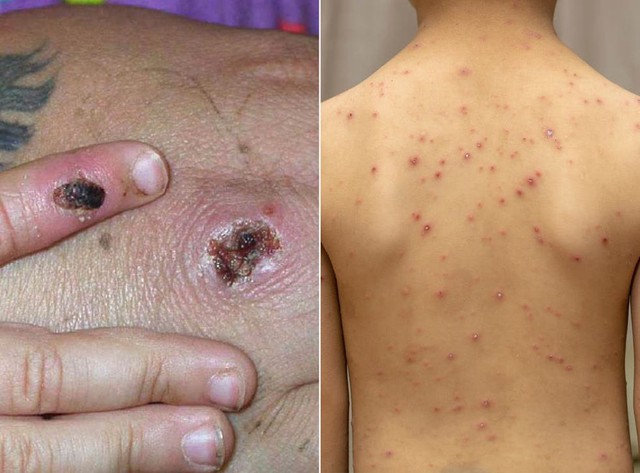Experts point out something unusual
What’s unusual in the recent monkeypox outbreak
Monkeypox is a rare disease caused by the monkeypox virus. Recently, the World Health Organization (WHO) held an emergency meeting to discuss the monkeypox outbreak in the context that Europe may have recorded more than 100 cases.
Monkeypox virus enters the body through lesions in the skin, respiratory tract or mucous membranes (eyes, nose, mouth). In humans, the virus is transmitted mainly through respiratory droplets, but it cannot travel to several meters, so close contact is required to infect. Based on epidemiological assessment, the potential for transmission of recent epidemics is mainly among people with multiple sexual partners.
Monkeypox virus, similar to smallpox, belongs to the genus Orthopoxvirus. This virus is similar in structure and pathogenicity to smallpox, but the illness is usually milder. Despite the name monkeypox, the disease is not caused by a virus of monkeys. The host for this virus is currently unknown, but the organisms most likely to be rodents and small squirrels live in the rainforests of Africa, mainly in western and central Africa.
Monkeypox was first discovered in 1958 when two outbreaks of the disease similar to chickenpox occurred in study populations of monkeys, when they contracted smallpox-like disease.
Hence the name monkey pox. The first case of monkeypox in humans was reported in 1970 in the Democratic Republic of the Congo and subsequently, monkeypox in humans continued to be reported in other Central and West African countries.
Since 2016, cases have also been confirmed and reported in Sierra Leone, Liberia. Cases of monkeypox in Africa are on the rise as humans increasingly encroach on the habitats of animals that carry the virus. Currently, the outbreak in Europe is raising concern because monkeypox rarely occurs outside of Africa.
Since May, more than 100 cases of monkeypox have been recorded, mainly in European countries, different from previous epidemics. What’s unusual about the outbreak is that it occurs in countries where the disease was not common before.

Monkey pox is spreading in many countries, illustration.
Symptoms of monkeypox
Currently, the cause of the spread of the disease is being considered by scientists, possibly stemming mainly from sexual contact with an infected person.
Monkeypox is related to smallpox, which was eradicated in 1980. Monkeypox is less contagious, has milder symptoms, and has a lower mortality rate than smallpox.
The incubation period (time from infection to symptoms) is usually 7-14 days but can be 5-21 days. The illness usually lasts 2 to 4 weeks, and symptoms can appear anywhere on the body 5 to 21 days after infection. Symptoms of monkeypox include:
– High body temperature
– Headache
– Muscle pain
– Backache
– Swollen lymph nodes (difference between smallpox and monkeypox)
– Shivering (chills)
– Exhausted
Rash (appears 1 to 5 days after the first symptoms and usually starts on the face, then spreads to other parts of the body).
Patients with monkeypox in the UK have a mortality rate of only about 1%, the level of danger is quite mild. However, we cannot be complacent. Although symptoms are milder than smallpox, most recently, statistics show that the mortality rate in monkeypox cases is about 3-6%.
Children, adolescents and people with weakened immune systems are at higher risk of severe illness and mortality. In addition, pregnant women infected with monkeypox will lead to complications, transmission from mother to fetus, or stillbirth.
Transmission route of monkeypox
Being bitten by or touching the blood, body fluids, spots, blisters, or scales of an animal infected with monkeypox.
– By eating the meat of an infected animal that has not been thoroughly cooked or by touching other products from the infected animal (such as animal skin or fur).
– Touching clothing, bed sheets, or towels used by a person with monkeypox.
– Touch the blisters or scabs on the skin of monkeypox.
– When in close contact with a person with smallpox, the monkey coughs or sneezes.

Symptoms of monkeypox virus (left) and a person with chickenpox (right). CDC/Getty Images.
Difference between monkeypox and chickenpox, smallpox
Here are the symptoms associated with monkeypox and how it compares to chickenpox and smallpox.

Detect and treat
– Monkeypox is diagnosed through PCR testing, based on samples taken from the patient’s rash.
The illness is usually mild and most patients recover within a few weeks. Treatment is primarily symptomatic and supportive, including prevention and treatment of secondary bacterial infections. Smallpox vaccine may be considered for post-exposure prophylaxis for close contacts who are at increased risk of severe illness, however a careful benefit/risk assessment for exposed persons should be performed. Additionally, antivirals are potential treatment options for severe cases.
According to the UK Health Security Agency, the smallpox vaccine, which can be used both before and after exposure, is up to 85% effective in preventing monkeypox.
– Wash your hands with soap and water often or use alcohol-based hand sanitizer.
Only eat meat when it has been thoroughly cooked.
– Do not approach wild or stray animals, unwell animals, including dead animals.
– Do not share beds or towels with people who are unwell and may have smallpox.
– Do not have close contact with people who are unwell and may have monkeypox.
According to WHO and ECDC, countries need to be alert to the above disease signals and any patient or animal suspected of having monkeypox should be investigated and if confirmed. Stay isolated until their lesions crust over, the scabs fall off, and a fresh layer of skin underneath forms. In most cases it is possible to stay at home with supportive care. Countries also need to continuously raise awareness among potentially affected communities,… to identify and prevent further secondary cases and effectively manage the current outbreak.
– Healthcare workers should wear appropriate PPE (gloves, waterproof gown, FFP2 respirator) when screening suspected cases or caring for a suspected case of monkeypox. Laboratory staff should also take precautions to avoid exposure to pathogens.
Group of authors:
Hoang Thuy Tien (Faculty of Pharmacy, Danang University of Medicine and Pharmacy, Da Nang).
Tran Huyen Thoai (Faculty of Pharmacy, Danang University of Medicine and Pharmacy, Da Nang).
Nguyen Tien Huy (Professor, PhD, BS; Faculty of Medicine, Nagasaki University, Japan)
References:
https://bit.ly/3sZW7j3
https://bit.ly/3lNG1VH
https://www.ncbi.nlm.nih.gov/pmc/articles/PMC2828073/?fbclid=IwAR3fX7KZ-ZFDM_uVl7oxrmENIikWOPLC4OcUboPGl-0VU1AfCrzMU4V3KlU
https://www.ncbi.nlm.nih.gov/pmc/articles/PMC8007331/?fbclid=IwAR034Z3LdJvRVR3n92UHG41zIbMJxhK_s8jklntDw0f2xPDpKuV5vLsf5y0
https://www.cdc.gov/poxvirus/monkeypox/index.html
https://www.nhs.uk/conditions/monkeypox/
https://www.who.int/emergencies/disease-outbreak-news/item/2022-DON385
https://www.who.int/news-room/fact-sheets/detail/monkeypox
https://bit.ly/3GnnE37
https://www.insider.com/monkeypox-smallpox-chickenpox-rash-symptoms-chart-virus-outbreak-2022-5
at Blogtuan.info – Source: cafebiz.vn – Read the original article here



